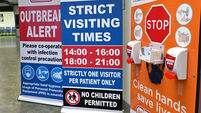Superbug killing more patients than MRSA, says HSE
Professor Brendan Drumm told an Oireachtas Committee that the bacterial organism is more fatal than MRSA in hospitals.
Infections most often occur in hospitals and it is mostly developed by patients who have recently taken antibiotics.
It results in diarrhoea, can be spread directly from patient to patient, and can be fatal, particularly in elderly patients.
Professor Drumm yesterday said that it was a bigger killer than MRSA.
He was responding to independent TD Paudge Connolly and to Fine Gael senator Fergal Browne, who suggested that the HSE publish the number of people who have died in Irish hospitals as a result of being infected with MRSA.
However, Prof Drumm said releasing such figures might pose a huge risk of unnecessarily traumatising people.
In that context, he pointed out that the mortality rates from Clostridium Difficile were higher than those of MRSA in Irish hospitals and elsewhere.
As many as 8,000 patients tested positive for so-called superbugs in Irish hospitals in 2004, with some 6,000 being infected by MRSA. However, only a small minority became ill from the infection, which becomes serious only when it enters the bloodstream.
It is not known how many people have died as a result of superbug infections in Ireland. The numbers are said to be low, and in some cases, would comprise one factor in the death of a patient with an already life-threatening condition.
“Hospitals are still dangerous places to be. It’s a fact of life the world over,” said Prof Drumm.
He said that the challenge for hospitals was to minimise risk for both patients and staff.
“We have to do the absolute best we can to protect employees. At the same time, patients have to be nursed.”
Tánaiste Mary Harney initiated a series of national audits of hygiene to deal with hospital infections.
Yesterday, she said that an additional €5 million had been provided to improve hygiene in hospitals and to deal with superbugs. She said the aim was to get Irish hospitals to the standards of north European countries.













